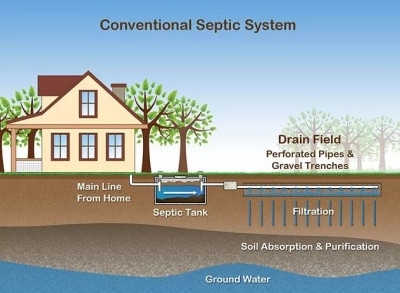If you’ve recently moved into a new home, you may be wondering what type of wastewater system you have. Is your home connected to the public sewer system? Or does it utilize a private onsite septic system? Recognizing the signs you have a septic tank can help you maintain it properly.
Septic systems are underground treatment facilities commonly used in rural areas without access to sewer lines. They use natural processes to filter and break down household wastewater. Identifying if your home has a septic tank is important so you can take care of it and avoid expensive repairs from neglect.
Read on to learn the telltale signs that indicate your home likely relies on a septic system.
Signs You Have a Septic Tank
Here are the top ways to recognize you have a septic system:
1. Your water bill doesn’t show sewer fees
Homes on municipal sewer lines get charged sewer service fees on their water bills. If your bill only shows water usage charges, that points to having a septic tank.
2. You have well water and no water meter
Similarly, private well water means you aren’t hooked up to public utilities. Lacking a water meter is another red flag as the city can’t bill for what they can’t measure.
3. You see lids or manhole covers in your yard
Septic access ports and manhole covers provide entry to the underground tanks for pumping and inspections. Spotting these is a dead giveaway.
4. Your property records or permit history mention a septic system
Any permits pulled for septic installation should be on file with your local health department or permitting office.
5. You find a large buried concrete or plastic tank
The main septic tank and any additional treatment tanks are buried on the property. You may locate them while landscaping.
6. Your neighbors have septic systems
If surrounding homes don’t seem connected to a sewer line, yours probably isn’t either. Rural areas often rely solely on septic.
7. You have a drain field with gravel and piping
The network of perforated pipes leading from the septic tank also provides clues you’re off the sewer grid.
How To Determine if You Have a Septic Tank
If you just moved in or remain unsure if your home relies on a septic system, here are some steps to sleuth it out:
Check your property and utility records
Any records from the sale should mention septic details. Contact the health department about permits.
Inspect the property for clues
Probe the yard with a metal rod to find buried tanks. Follow pipes from the home.
Ask neighbors
They may know if the area uses septic systems universally.
Contact your local utilities
The city can confirm if they have your home on the sewer lines.
Hire a professional
Septic inspectors can definitively determine if you have a septic system.
Locating Your Septic Tank and Drain Field
Once you confirm or conclude you have a septic tank, take steps to identify the system’s key components on your property:
-
Review any permits, property surveys, and system records for tank size and location.
-
Visually scan the yard for lids, manholes, or any indicators of buried infrastructure.
-
Use a metal probe to locate underground tanks and pipes. Focus your search about 10-20 feet from the home.
-
Follow the sewer pipe exiting your home to find the tank it connects to.
-
Look for areas with greener, lusher grass, which may indicate the drain field.
-
Create a simple sketch mapping your septic system’s layout.
Knowing where your septic system lies allows safer landscaping, additions, and excavations. And you’ll know right where to go when it’s time for pumping and maintenance!
Why Identifying You Have Septic is Important
There are several critical reasons determining if you have a septic tank matters:
1. Septic systems require special care and maintenance
You must have the tank pumped, system inspected, and properly cared for.
2. It impacts what goes down your drains
Septic-safe soaps, detergents, and products should be used to protect bacteria.
3. Septic systems have a finite capacity
Knowing size and age helps avoid overloading and premature failures.
4. Drain fields need protection
You must avoid compaction, planting trees over it, and drainage issues.
5. Failing septic systems are hazardous
Improper wastewater disposal can threaten health and contaminate water.
6. Unidentified septic tanks get neglected
Lack of maintenance shortens system lifespan and can lead to expensive repairs.
7. Septic systems must be located before any digging or construction
Accidentally hitting or crushing your buried system causes big problems.
Maintaining Your Septic Tank
Once you know you have a septic tank, here are some tips to keep it running properly:
-
Inspect annually – Check components and measure sludge/scum levels.
-
Pump regularly – Pumping frequency depends on tank size and household size. Typical is every 3-5 years.
-
Use septic-safe products – Avoid bleach, chemicals, and antimicrobials that disrupt helpful bacteria.
-
Conserve water – Fix any leaks immediately and spread out usage over the week.
-
Don’t flush or pour hazardous items – Grease, paper towels, wipes, feminine products, paints, etc. can clog.
-
Don’t use garbage disposals – Food waste overwhelms the septic tank. Compost instead.
-
Protect the drain field – Don’t drive or park vehicles on it. Plant only grass.
Knowing if you have a septic tank allows you to take proper care of your system. With attentive maintenance and responsible household habits, your septic system can reliably serve your home for decades. Contact a professional if you have any concerns about your septic tank’s health or location on your property.
